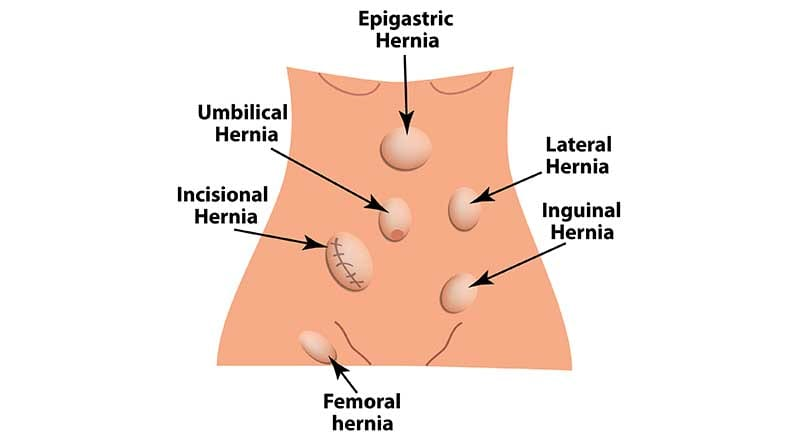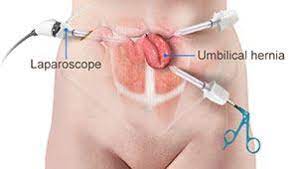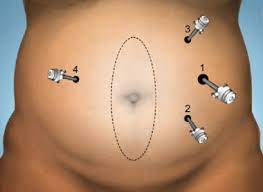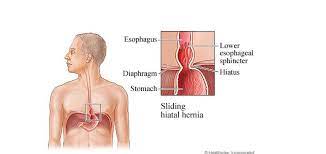What is Inguinal Hernia and why is it caused?
When the inner layers of the abdominal wall weaken, a hernia forms,
resulting in a bulge or rip.
As the inner tube punctures the damaged tyre, the abdomen’s inner lining
presses against the weakest part of the abdominal wall, generating a
balloon-like sac. The intestine loops or the abdominal tissue rips as a result
of this.
Tissue weakening can be caused by a variety of factors, including natural
weakness, heavy lifting, chronic coughing, and straining with bowel movements
or urination.

What are the advantages of this
surgery?
The treatment uses small incisions, which take less time to heal and allow the patient to return to their normal routine fast.
What are the treatments
available?
There are numerous treatment methods available, and the surgeon may recommend one based on the medical history of the patient.
What is Laparoscopic
hernia repair?
The procedure for laparoscopically correcting a hernia is the same as
for other laparoscopic procedures. The surgeon makes incisions through which a
laparoscope (a laparoscope is a small instrument with a narrow tube that has a
light source and camera at the end of the tube) is inserted, and the surgeon
uses the Laparoscope’s video camera to locate the hernia; the hernia is then
reduced with the help of surgical equipment through the other incisions made;
and the incisions are then sealed using surgical glue or staples.
Depending on the severity of the hernia, the doctor may do an open procedure.
Laparoscopic Umbilical Hernia Repair

What is an Umbilical Hernia?
An umbilical hernia occurs when tissues from the intestine or abdominal
cavity push through a soft/weak part of the abdominal wall at the belly button.
The intestine loops or the abdominal tissue rips as a result of this.
Tissue weakening can be caused by a variety of factors, including natural weakness, heavy lifting, chronic coughing, and straining with bowel movements or urination. This is a condition that can affect adults as well as children.
What are the symptoms of
Umbilical hernia?
The symptoms of Umbilical hernia are as Follows :
· Swelling at Naval region
· Severe pain in the abdomen region
· The affected area might turn blue
How is the laparoscopic repair of umbilical hernia surgery
carried out?
A laparoscopic operation is a technique that allows you to see within
your body Umbilical hernia repair, like other laparoscopic operations, is done
under anaesthesia.
Where the surgeon makes incisions through which a laparoscope (a laparoscope is
a small instrument with a narrow tube that has a light source and camera at the
end of the tube) is inserted, and the hernia is located using the Laparoscope’s
video camera, and the hernia is reduced with the help of surgical equipment
through the other incisions made; to strengthen the abdominal walls, the
surgeon may place a synthetic mesh and sew it in place.
The doctor may choose for an open therapy depending on the severity of the
hernia.
Laparoscopic Repair of Ventral Hernia
What is Laparoscopic Repair of Ventral Hernia ?
A ventral hernia is an abdominal protrusion caused by a muscular
opening. The hernia is repaired laparoscopically. When a person has had
previous Laparoscopic surgery or when muscles, particularly the abdominal
muscles, are weak, this problem can arise.
Laparoscopic ventral hernia surgery is similar to other Laparoscopic procedures
in that a Laparoscope is inserted through abdominal incisions.

What are the symptoms of Ventral Hernia?
Some of the symptoms are:
· Sharp pain in the abdomen
· Visible bulge of the abdominal wall
· Nausea
· Vomiting and indigestion
How is the surgery performed ?
To help the surgeon discover the hernia, the physician makes three to
four incisions through which air (carbon dioxide) is pumped.
The surgeon next inserts a laparoscope (a small tool having a narrow tube, a
light source, and a camera at the end of the tube) and utilises the video
camera on the laparoscope to locate the hernia. The hernia is subsequently
reduced using surgical instruments through the previous incisions made; the surgeon
may use a synthetic mesh and suture the area to strengthen the abdominal walls.
Surgical glue or staples are used to close the incisions. The doctor may
propose surgery depending on the severity of the hernia.
What are the advantages of this surgery ?
Small incisions are used in the procedure, which take less time to heal
and allow the patient to return to regular life quickly.
What are the other avenues of treatment available apart from surgery ?
There are numerous treatment methods available, and the surgeon may
recommend one based on the medical history of the patient.
If surgery is not an option for the patient, a ‘Truss,’ which is a belt that maintains the hernia in place as the patient goes about his daily activities, may be recommended.
Laparoscopic Hiatal Hernia Repair

What is Hiatal hernia?
A hiatal hernia occurs when the contents of the abdominal cavity protrude beyond the esophageal hiatus of the diaphragm. The following variables contribute to hiatal hernia:
· An expanded esophageal hiatus is caused by
developmental defects.
The thoracic-abdominal pressure gradient has widened. The phrenoesophageal membrane loses its elastic fibres as it ages.
What are the Different types of
hiatal hernias?
There are four types of hiatal hernias they are:
·
The gastroesophageal junction is forced into
the thoracic cavity, causing a sliding hernia. This is one of the most common
types of hiatal hernias, accounting for roughly 95 percent of all cases.
The second type is a paraesophageal hernia, in which the gastroesophageal
junction is preserved but the gastric fundus protrudes across the diaphragmatic
hiatus.
In the third sort, both the gastroesophageal junction and the stomach herniate
above the diaphragm.
The fourth type of hernia occurs when organs other than the stomach protrude
above the diaphragm, such as the colon.
What are the symptoms of
hiatal hernia?
The symptoms of hiatal hernia are :
· Difficulty in swallowing food
· Shortness of breath
· Chest and abdominal pain
· Backflow of stomach acid into the esophagus or acid reflux
· Vomiting of blood or passing of black stools, which may indicate gastrointestinal bleeding
· Feeling full as soon as you finish eating
· Heartburn

